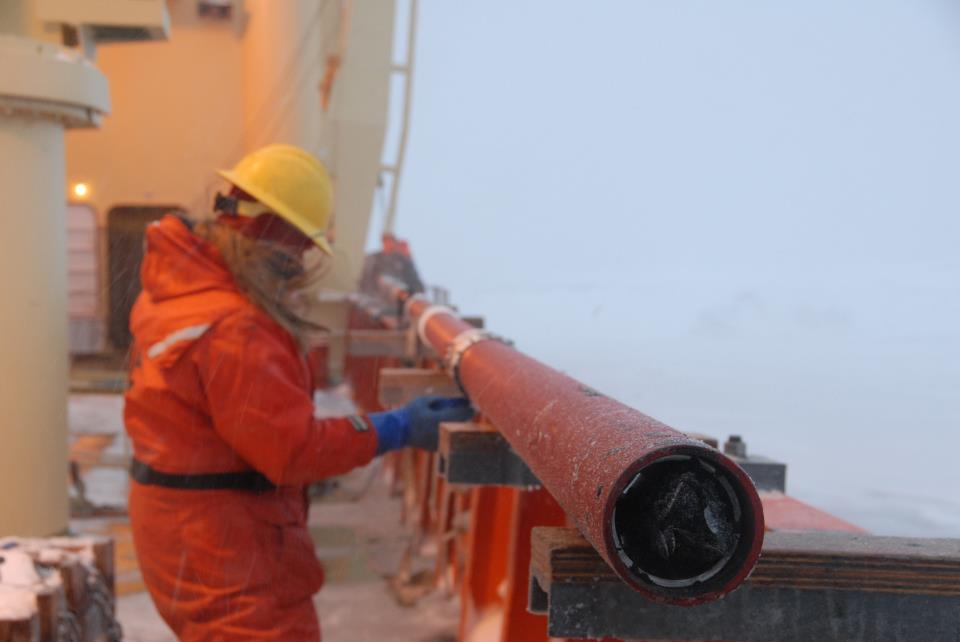

Julia Wellner extracts sediment cores near the Larsen ice shelf, similar to what Rachel Clark and other researchers will be doing around Thwaites Glacier in 2019 and 2020. | Courtesy of Kathleen Gavahan
The Department of Earth and Atmospheric Sciences at UH received a $1 million grant from the National Science Foundation in March to conduct and lead THwaites Offshore Research — one of the eight projects of the International Thwaites Glacier Collaboration.
Julia Wellner, an associate professor in the Department of Earth and Atmospheric Sciences at UH, will lead the joint effort consisting of researchers from Britain, Rice University, University of Alabama and Columbia University, where they’ll collect sediments deposited in the ocean floor adjacent to Thwaites in the hopes of producing more accurate models of future sea level rise.
“Is it the canary in the coal mine?” Wellner said, an advanced warning phrase originating when coal miners would put canaries in the mines and would die if methane levels got too high signaling the miners to get out. “Right now Thwaites is contributing only 4 percent to sea level rise, but it has the potential of being much larger”
THwaites Offshore Research (THOR) will be the largest joint U.S., British research project since at least the 1940s, Wellner said. The reason being that 1,000 miles separate Thwaites from both the U.S. and British Antarctic bases —the closest places to the Florida-sized glacier, she said.
“Imagine trying to study the Texas, New Mexico border from a small camp in Baton Rouge,” Wellner said. “That’s the scale we’re looking at.”
Thwaites has long been considered the “weak underbelly” of the Antarctic ice sheet, Wellner said. Ocean water comes in contact with a majority of the glacier, making it vulnerable because of the ice sheet’s position below sea level and rising temperatures, she said.
If the Antarctic ocean becomes warm enough, then Thwaites Glacier will begin melting from below, and if this happens, no evidence exists that it’ll stop melting, potentially contributing one meter to sea level rise, Wellner said. The glacier’s rate of melting has already doubled since the 1990s, she said.
The Intergovernmental Panel on Climate Change has a range of global sea level predictions, but most of the uncertainties come from their lack of understanding of the Antarctic ice sheet, Wellner said.
“We want to know what Thwaites was doing before the satellites were launched,” Wellner said. “If I find that it’s entering a face of retreat, then that will be incorporated into modeling efforts.”
The group of scientists begin their first field mission in Jan. 2019 and a second one in 2020. Wellner’s group consists of about 10 scientists, an average size compared to the other seven groups, Wellner said.
Wellner’s team plans on collecting sediments deposited in the ocean floor near Thwaites during their 60-day expedition. Then, they’ll bring back the samples to date them at UH.
Wellner selected Rachel Clark, a first-year geology graduate student, to go on both field missions. Clark will work 12-hour shifts on the internet-free Nathaniel Palmer, an icebreaker frequently used for Wellner’s research expeditions.
“When I was figuring out where I was going to school, (Wellner) told me this was a possibility, and she sent me on this cruise in her place,” Clark said.
She will be collecting sediment cores, describing their characteristics and dating them at UH. In preparation for the trip, Clark began compiling existing data on Thwaites to understand how the glacier works.
At Rice University Lauren Simkins, a postdoctoral research associate, will be one of the university’s faculty going to Antarctica in 2020.
“This long-term perspective is necessary to improve models that will hopefully be able to tell us with some degree of certainty how much we can expect to lose from Thwaites Glacier and its associated contribution to rising sea levels,” Simkins said.
Simkins said they’ll be analyzing the sea floor Thwaites used to be in contact with, so the glacier’s retreat in the past century can be evaluated — something necessary to improve ice sheet models predicting sea level rise.
“Hopefully, in the future, we can say here are some processes that can contribute to its stability,” Simkins said. “But we really don’t know what we’re going to find.”
news@thedailycougar.com
—
“UH professor leads $1 M research effort to understand Thwaites Glacier” was originally posted on The Daily Cougar
